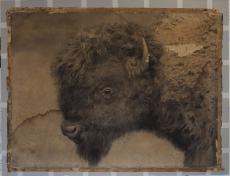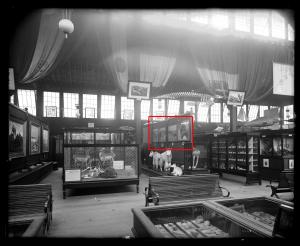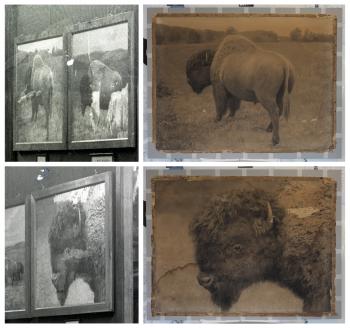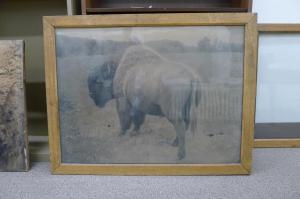 Last year, we shared with you our conservation treatment of two large-scale crayon enlargements depicting an American bison. At the time, little was known about them, including the exact process by which they were made, or by whom, or for what purpose. Given the subject of these images, it was theorized that there might be a connection between them and William Temple Hornaday, founder of the National Zoo and nineteenth-century champion of natural conservation, especially that of bison. This link was only postulated, as there was no direct evidence for it.
Last year, we shared with you our conservation treatment of two large-scale crayon enlargements depicting an American bison. At the time, little was known about them, including the exact process by which they were made, or by whom, or for what purpose. Given the subject of these images, it was theorized that there might be a connection between them and William Temple Hornaday, founder of the National Zoo and nineteenth-century champion of natural conservation, especially that of bison. This link was only postulated, as there was no direct evidence for it.
Flash forward ten months: at the end of last year, one of our Institutional History fellows, Sherri Sheu from the University of Colorado Boulder, presented a lecture to Archives staff on an offshoot research project from her main focus on the environmental history of bass fishing. This lecture focused on Hornaday’s contribution to the 1888 Cincinnati Centennial Exposition of the Ohio Valley and Central States: an exhibit entitled “Extermination Series.” This was described in the Official Guide as a group of specimens “of all the larger animals which are rapidly disappearing from the country. … The bison or American buffalo is the object of special attention, and the methods employed in its destruction are fully shown in a series of pictures.” In her lecture, Sheu also included a photograph from the exposition showing a spectacular view of Hornaday’s exhibit, with cases, pictures, and additional didactics visible alongside other exhibits in the venue.
As I gazed at the photographs, my eye was drawn to a four-part series of framed images displayed on the wall divider. Though they were photographed at an angle and not particularly prominent in the frame, two of the framed images bore a strong resemblance to the two bison enlargements I had in our collections storage. This generated significant excitement among our staff when I shared our observation. Senior Conservator Nora Lockshin worked with our Photo Archivist Marguerite Roby to obtain a higher-quality scan of the original glass plate negative and to enhance the relevant portions, hoping to be able to make a stronger link.

 Our enhanced image does indeed confirm the link between Hornaday’s exhibition and the crayon enlargements. The compositions of these images are identical, insofar as we can determine, to those of the crayon enlargements at the Archives. In addition, the simple wooden frames around the exhibition images appear to be the same as those which originally housed our crayon enlargements.
Our enhanced image does indeed confirm the link between Hornaday’s exhibition and the crayon enlargements. The compositions of these images are identical, insofar as we can determine, to those of the crayon enlargements at the Archives. In addition, the simple wooden frames around the exhibition images appear to be the same as those which originally housed our crayon enlargements.
What does this mean for our objects? Though we still cannot identify the precise method of creation nor their maker, we can demonstrate that these crayon enlargements are likely those created for Hornaday’s contribution to the 1888 Cincinnati Centennial Exposition. This link provides context and meaning to the enlargements that enriches their materiality as part of our holdings. Though the images already had a physical home, they now have a conceptual home amongst the related collections.
Related Resources
Re-mounting the American Bison, The Bigger Picture, Smithsonian Institution Archives
Taxidermist Turned Conserationist: The Man that Saved the Bison, The Castle of Curiosities
William Temple Hornaday: Saving the American Bison, Smithsonian Institution Archives
Produced by the Smithsonian Institution Archives. For copyright questions, please see the Terms of Use.

Leave a Comment